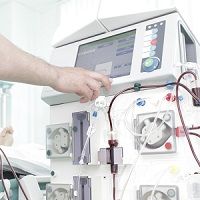Mortality Rates From CV Cause of Death Saw Improvement with Dialysis
After adjustment for age and sex, data show the reduction in mortality rates in the patients receiving dialysis was greater than the general population.

New findings observed the mortality rates for myocardial infarction, stroke, and pulmonary embolism decreased between 1998 and 2015 in both patients receiving dialysis and the general population.
However, following adjustments for age and sex, the reduction in mortality rates from cardiovascular causes in the dialysis population was found to be greater than the reduction in the general population.
“Although mortality rates declined, clinicians should still be aware of the poorer outcomes of myocardial infarction, stroke, and pulmonary embolism for patients receiving dialysis compared with the general population,” wrote study author Gurbey Ocak, MD, PhD, Department of Internal Medicine, Sint Antonius Hospital.
The study consisted of a cohort of incident adult patients receiving dialysis from 11 European countries composed of 8 national and 8 regional kidney registries in the European Renal Association (ERA) Registry.
Included patients began dialysis between January 1998 - December 2015 and were followed for a maximum of 3 years until death, censoring for the recovery of kidney function, kidney transplantation, or loss to follow-up.
Investigators categorized the causes of death according to the coding system of the ERA Registry, which provides a standardized classification of causes of death in patients receiving kidney replacement therapy. Mortality data for the general population in the corresponding 11 European countries were used as a reference and obtained from the World Health Organization.
The mortality rate ratios with 95% confidence intervals (CI) were calculated for 3 equal and predefined periods (1998 - 2003, 2004 - 2009, and 2010 - 2015) by dividing the mortality rates in patients receiving dialysis by the mortality rate in the general population.
A total of 220,467 patients receiving dialysis were included in the study, with 82,068 female patients (37.2%) and a median age of 68.2 years. Data show the percentage of male patients receiving dialysis increased from 40,412 (61.0%) in the 1998 - 2003 period to 49,852 (64.4%) in the 2010 - 2015 period.
In the follow-up period, 83,912 patients receiving dialysis died. From this cohort, 7662 (9.1%) died due to myocardial infarction, 5030 (6.0%) died because of stroke, and 435 (0.5%) died because of pulmonary embolism.
Data show the SMR of myocardial infarction decreased from 8.1 (95% CI, 7.8 to 8.3) between 1998 and 2003 to 6.8 (95% CI, 6.5 to 7.1) between 2010 and 2015.
The SMR for stroke also decreased over time from 7.3 (95% CI, 7.0% to 7.6%) between 1998 and 2003 to 5.8 (95% CI, 5.5% to 6.2%) between 2010 and 2015.
The SMR for pulmonary embolism decreased from 8.7 (95% CI, 7.6 to 10.1) between 1998 and 2003 to 5.5 (95% CI, 4.5 to 6.6) between 2010 and 2015.
Moreover, in patients receiving dialysis, there was no observed decrease in mortality rates of other causes of death between 1998 and 2003 (annual percentage change [APC], 1.0%; 95% CI, -0.3 to 2.3), while there was a decline between 2003 and 2015 (APC, -0.9%; 95% CI, -1.2 to -0.5).
Although mortality rate ratios were observed to be consistently higher among females, investigators found SMRs decreased over time for both females and males. Additionally, mortality rate ratios for different cardiovascular causes of death decreased consistently over time in patients aged ≥65 years.
The study, “Trends in Mortality Due to Myocardial Infarction, Stroke, and Pulmonary Embolism in Patients Receiving Dialysis,” was published in JAMA Network Open.